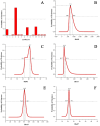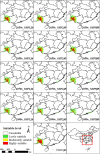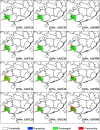Prediction of potential suitable habitats of Malania oleifera under future climate scenarios based on the MaxEnt model
- PMID: 40691193
- PMCID: PMC12280065
- DOI: 10.1038/s41598-025-09800-7
Prediction of potential suitable habitats of Malania oleifera under future climate scenarios based on the MaxEnt model
Abstract
Malania oleifera is a nationally Category II protected wild plant in China and a Vulnerable species on the IUCN Red List, specifically distributed in the karst forest, playing a crucial role in maintaining biodiversity and ecological balance in karst fragile ecosystems. In this study, the potential suitable habitats for M. oleifera were simulated by the MaxEnt model using 126 distribution records and 19 environment variables. The key environmental variables influencing its distribution were identified: topsoil USDA texture classification (t_usda_tex), precipitation of warmest quarter (Bio18), isothermality (Bio03), precipitation of driest quarter (Bio17), precipitation seasonality (Bio15), and temperature annual range (Bio07), which are clay soil, 606-882 mm, 33.1-43.5, 40.7-67.2 mm, 76.9-86.7%, and 20.6-23.1 °C, respectively. Under the future climate scenarios, the total area of suitable habitats for M. oleifera is expected to decrease, with a more significant reduction under the SSP585 scenario compared to the SSP126 and SSP245 scenarios. Compared to the current centroid of the suitable habitat, the future centroid is projected to shift southeastward. This study identifies stable habitats of M. oleifera in the Guangxi-Yunnan-Guizhou border region, recommending prioritized in situ conservation and breeding base development. Environmentally sensitive zones require continuous monitoring and adaptive protection strategies. Climate-adaptive cultivation trials are proposed for expansion areas like Guangdong. These findings offer scientific and practical guidance for sustainable management of this vulnerable species under climate change.
© 2025. The Author(s).
Conflict of interest statement
Declarations. Competing interests: The authors declare no competing interests.
Figures








Similar articles
-
[Prediction of suitable habitats of Phlebotomus chinensis in Gansu Province based on the Biomod2 ensemble model].Zhongguo Xue Xi Chong Bing Fang Zhi Za Zhi. 2025 Jun 6;37(3):276-283. doi: 10.16250/j.32.1915.2024223. Zhongguo Xue Xi Chong Bing Fang Zhi Za Zhi. 2025. PMID: 40730525 Chinese.
-
Predicting the distribution of Blyth's kingfisher (Alcedo hercules) in the Eastern Himalayas: a climate-sensitive ensemble modelling approach.Environ Monit Assess. 2025 Jun 21;197(7):789. doi: 10.1007/s10661-025-14213-0. Environ Monit Assess. 2025. PMID: 40542908
-
Optimized MaxEnt analysis revealing the change of potential distribution area of Lygodium japonicum in China driven by global warming.Front Plant Sci. 2025 Jun 19;16:1601956. doi: 10.3389/fpls.2025.1601956. eCollection 2025. Front Plant Sci. 2025. PMID: 40612605 Free PMC article.
-
A scoping review of tropical pioneer trees' roles for restoration and conservation management: Harungana madagascariensis (Hypericaceae) a widespread African species as a model.PeerJ. 2025 May 23;13:e19458. doi: 10.7717/peerj.19458. eCollection 2025. PeerJ. 2025. PMID: 40421372 Free PMC article.
-
Cross-border ungulate protection: Identifying transboundary conservation challenges and integrated solutions in response to human disturbance and climate change.J Environ Manage. 2025 Sep;391:126483. doi: 10.1016/j.jenvman.2025.126483. Epub 2025 Jul 14. J Environ Manage. 2025. PMID: 40663892
References
-
- Qiu, H. & Gilbert, M. G. Flora of China, Vol 5 Olacaceae. In Flora of China (eds Hughes, M. et al.) (Science Press and Missouri Botanical Garden Press, Beijing, 2003).
-
- Tang, T.-F. et al. Constituents of the essential oil and fatty acid from Malania oleifera. Ind. Crops Prod.43, 1–5 (2013).
-
- Merrill, A. H. et al. Importance of sphingolipids and inhibitors of sphingolipid metabolism as components of animal diets. J. Nutr.127, 830S-833S (1997). - PubMed
-
- Sinclair, A. J. & Crawford, M. A. The incorporation of linolenic acid and docosahexaenoic acid into liver and brain lipids of developing rats. FEBS Lett.26, 127–129 (1972). - PubMed
MeSH terms
Grants and funding
LinkOut - more resources
Full Text Sources
Medical

